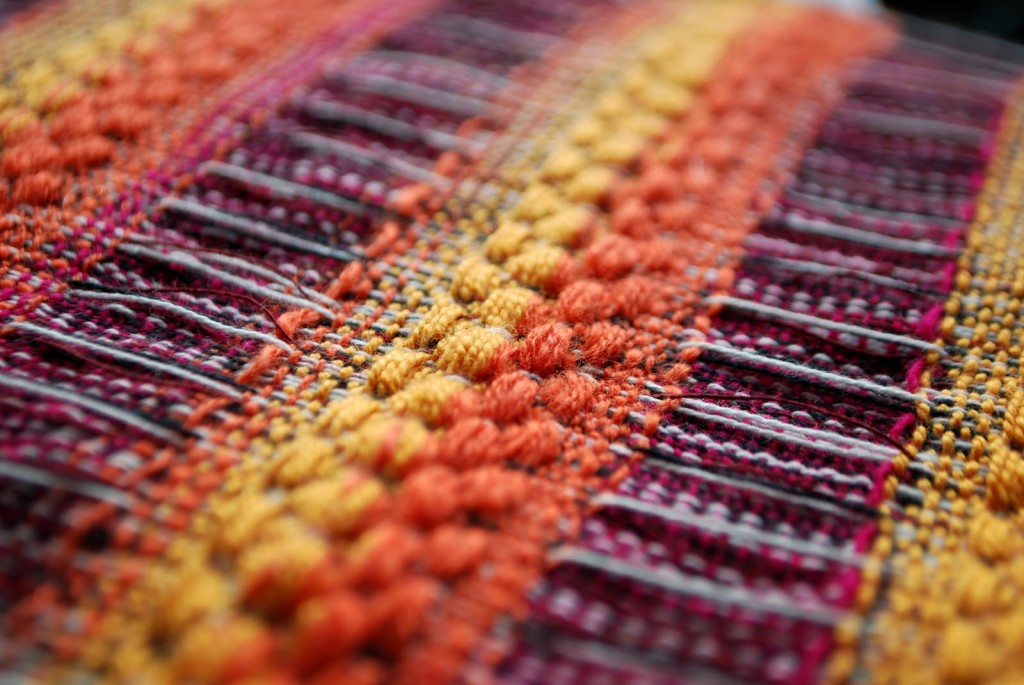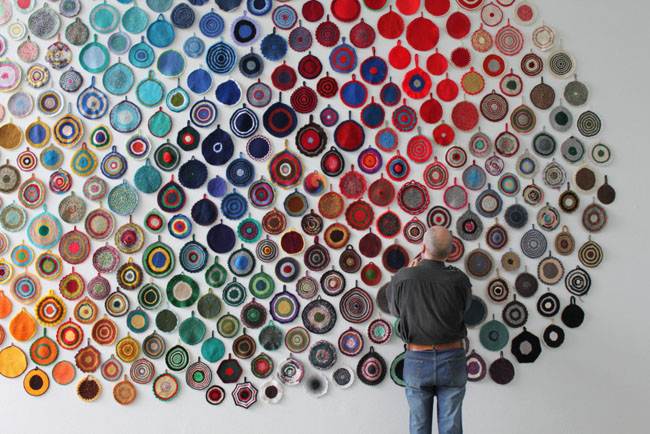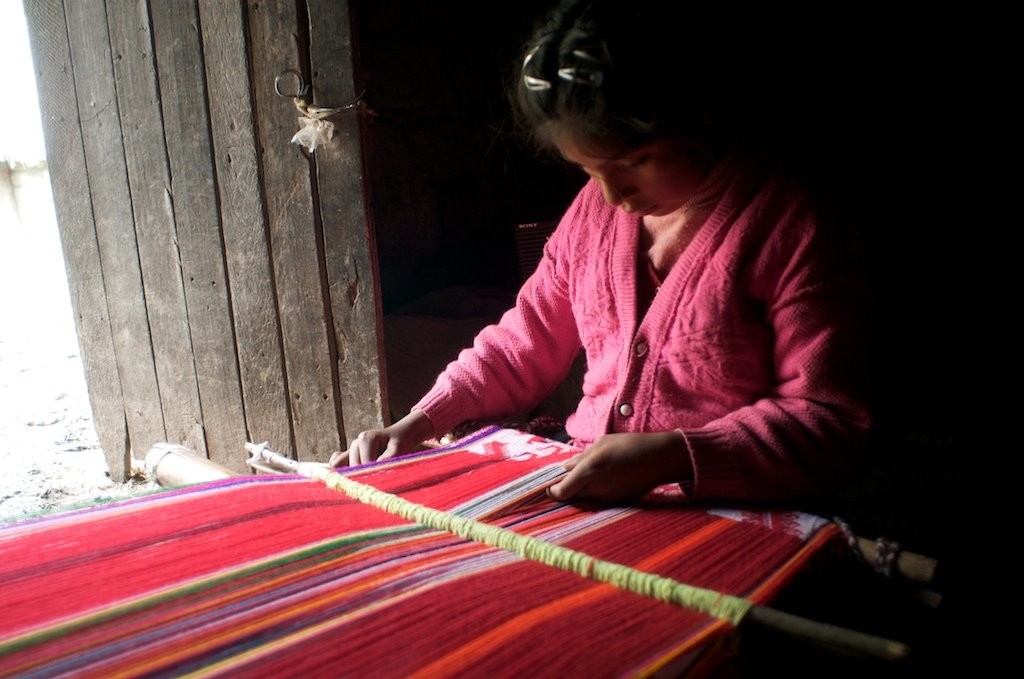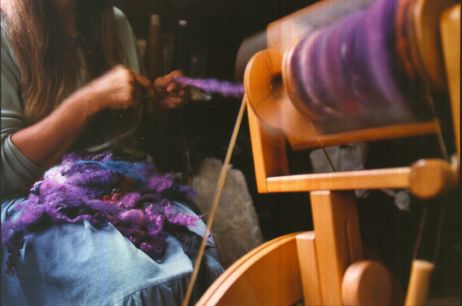Above: Potholder fiber art. [Source]
We live in the age of the touchscreen, of the portable phone, of information at our fingertips, yet other than liking, clicking or selecting, we don’t really use our hands for much anymore. We use our fingers to press the buttons on the microwave to cook our food, perhaps even turn on a burner, we clutch the remote to change the channel, we turn the doornob to open the door and we push the key into the lock. We touch as little as we need to in order to accomplish the task. In fact, even with the touchscreen, the goal is to minimize the amount of touch, to make it even more sensitive, so less pressure, or touch is required. While, efficiency is great, we are losing contact with the powerful sensory experience of touch; we are losing our tactile traditions.
We all know of the sensual nature of touch when it comes to romance but there far more to experience than just romance… we have forgotten.
I am a very tactile person. I love to feel things with my fingers. Perhaps I came from an earlier time when women sat around making lace. While some women today might see that as subjugation, forcing women into “domestic tasks”, the idea of having the freedom to spendthe day on such an intricate meditative task as lace-making seems downright thrilling to me.

Me with my Tante who taught me to knit, crochet, sew and cook. Photo by David X Young.
Perhaps it came from a wonderful woman, my Tante, who was literally my second cousin, twice removed, but figuratively my grandmother and my mentor. She taught me to knit and crochet when I was just 5 years old and soon after to sew and embroider, by hand as well as on a machine. Last but not least ,she showed me how to cook, without a recipe, with a smidgen of this and a pinch of that.

The texture of yarn and other fibers is very soothing to work with.
For me, using my hands had magical results. I grew up limited in terms of mobility, unable to run and jump like other children but with my hands I had amazing results. I could make all sorts of things, from barbie blankets and doll clothes as a child, to sweaters and afghans as an adult. In fact, I have been working with my hands so long that I can copy just about any craft without a pattern because the tools are my fingers, which after years of use, have been programmed with immense tactile traditions.
It is no wonder to me that, in this age of so much connection via electronic devices while so much disconnection from the real world, that many people are returning to tactile traditions to relieve the stress of our hectic life. Coloring intricate patterns addresses the need to touch something that does not have electrodes, even just a pencil, and the patterns allow our mind to disengage, thereby allowing the brain to drift and relax.
Studies have shown that knitting and crocheting have a similar effect and what is even better is that while you are meditating, you are also creating something of beauty and use. Coloring books are fun but it is not like you are making art. The key to benefiting, is getting good enough at the skill that you fingers know what you are doing and you can disengage from ‘active’ thinking.
There are so many ways we can engage in the tactile world. In addition to fiber arts, there is beading and jewelry making, woodworking, gardening and much more. Of course there are still plenty of us who incorporate it into our lives but the difference is that it is losing a place in our daily lives, for ordinary people who do not seek it out. In olden days we used our hands more to complete daily tasks but step by step, machines have replaced our hands with automation.

Beads and buttons are a great medium for simple crafts.
I am not advocating a return to churning our own butter or scrubbing clothes on a washboard, but I am advocating that we as a culture, a society, need to seek ways to bring tactile experiences back into our daily lives. Similar to how one is encouraged to take the stairs instead of the elevator when one is trying to lose weight or gain strength, finding ways to make or repurpose things instead of always buying them. We are feeling the lack of tactile traditions in our lives and also have lost the magic of creating something with our hands, of playing with color, texture and form to create something useful and beautiful.
Whenever I go somewhere and bring a project I’m working on, usually knitting, people gather around me in interest. Children hover as if in a trance, watching my fingers manipulate the needles as if I’m performing a magic trick. They all express a desire to learn, to understand yet few actually have the attention span to do it. An unfortunate side effect of our efficient time is that many of these skills take longer to learn than most will allow. We want to do everything quickly and perfectly. Mastering a skill seems too overwhelming, out of reach.
So perhaps it is true that I have connections to an earlier time, connections that not many others have, because I would not only like to have more time to create with my hands and less time on the computer, but to simplify my life to the point where I can add a spinning wheel and loom to my baskets of yarn, multitude of knitting needs, 4 sewing machines, boxes of beads… yes I’m quite connected to my tactile traditions.
While I may be unusual, I know I am not alone. Take the yarn bombing trend for example — people covering trees, statues, light posts, you name it, with colorful yarn. Now that is the kind of ‘bombing’ I can engage in!
So you say you can’t draw a straight line** or thread a needle and therefore crafting is out of the question, then there is one very obvious way to connect to tactile traditions and that is to cook, the more from scratch the better. Chop your own veggies, stir, braise, saute and season. Your hands are engaged and your home gets filled with the scents of freshly cooked food.
I saved cooking for last because it is the most accessible. If you already cook then the next step is to engage even further. Do more by hand and involve your children. Cook when you have hours free with no pressure or stress. Mixing ingredients and spices can be just as satisfying as the clicking of needles. And while you are cooking, you are reinforcing traditions for generations to come.
I was lucky to have had such instruction as a child. While I cook with my children, I have yet to engage them in other tactile arts to the same level I was as a child (too much competition from electronic media) but it is not for lack of trying. Still, I hope they will come to them in time, when the power of electronic media fades, and then they will learn first hand what touch is really about.
** My father, an artist, used to scoff at the statement about “not being able to draw a straight line” because in his view, a straight line was not a demonstration of artistic talent, “that’s what rulers are for”, he would say.







